
Chain driven differential
Sven - 10/4/05 at 06:04 PM
I could have put this in middy or BEC sections. Anyway, this is the URL of a guy building a dry lakes speed record car with a tranverse mounted
motorcycle engine. He goes into some detail about how he converted a conventional car differential to chain drive and inboard brakes:
http://purplesagetradingpost.com/sumner/bvillecar/bvillecarindexpage.html
His methods for designing his frame is also very interesting.
-Steve
[Edited on 4/10/2005 by Sven]
andylancaster3000 - 10/4/05 at 06:31 PM
I do like that rear drive system, very neat. For a while i've been thinking about making a chain drive diff from a normal car diff. What i am
confused about is the fact that the diff gears need to run in a bath of oil, which in that open system, it can't!. Would it be ok to mill the
edges of the open part flat the screw a plate onto either side with grease inside of it?
Alot cheaper then the only other alternative from quaife, but then that is an ATB diff.
Andy
Aloupol - 10/4/05 at 06:41 PM
It shouldn't be that difficult to build a cover with steel sheets or from a short wall thickness piece of tube.
I think it's the way used in all the grasstrack things or the R1ot or the first Radicals?
dblissett - 10/4/05 at 08:22 PM
in the kit car mag i think the riot uses a fiesta diff moded to the same effect
i couldent see how it was done from the mag tho
that to uses a chain drive look a neat job
dave
kb58 - 11/4/05 at 12:20 AM
I believe they just have a cup machined to slip over the diff, with a seal at the bottom for one axle exit. The top, open end, bolts to the ring gear
flange, again with a seal.
Rorty - 11/4/05 at 04:24 AM
quote:
Originally posted by kb58
I believe they just have a cup machined to slip over the diff, with a seal at the bottom for one axle exit. The top, open end, bolts to the ring gear
flange, again with a seal.
Correct. I've done it to Mini and Golf diffs. I usually get the guys who spin my wheel rims to spin me a thing that looks like a desktop lamp
shade which slips over the diff and is sealed by an O ring close to the CW flange and at the opposite end by another (much smaller) O ring. The whole
lot is kept in place by the RH bearing/plummer block.
A simpler cover could be welded up from some suitably sized aluminium (or steel I suppose) tube with an end plate.
I usually weld a bung into the side of the cover for adding/draining the oil.
I read on another thread here recently that the Escort English diff has just a few holes in the casting which could be welded up thus doing away with
the need for a cover. Just don't forget to add an oil bung.
Spyderman - 11/4/05 at 02:38 PM
A fascinating site and very useful for ideas!
I like the chain drive diff, but would question his planning! Alot of it is trial and error, not bad in itself, but why make a spacer for the sprocket
and then machine the diff down as well? Plus using different materials together does not sound good engineering practice to me.
Also for the purposes of the vehicle why even bother with a differential at all? He is hardly going to need to make sharp turns!
A locked diff would be far simpler and lighter.
I hope he is going to make a steel or alloy cage for the cockpit. I wooden  fancy driving inside a wooden body at anything above 100mph.
fancy driving inside a wooden body at anything above 100mph.
I know aircraft were made of wood, but they were not designed to survive a crash.
Got to be worth keeping an eye on now and then to see progress.
Terry


[Edited on 11/4/05 by Spyderman]
Sven - 11/4/05 at 02:59 PM
quote:
Originally posted by Spyderman
Also for the purposes of the vehicle why even bother with a differential at all? He is hardly going to need to make sharp turns!
A locked diff would be far simpler and lighter.
He says in his diary he has a welded up spider gear that he plans to use, which is, essentially, a locked diff/spool.
FWIW, I have a friend in Payson, AZ who built a +200mph salt racer and the last thing on his mind was saving weight. in fact the opposite, a light
weight lakes racer would be unstable. For example, rather than use a radiator my friend uses a 30gal total loss water tank placed in the car to help
traction and balance.
AFAIK, all the lakes racers use frames made from scraps of wood and fibre board ...  ...
...
-S
Sven - 11/4/05 at 03:02 PM
quote:
Originally posted by Rorty
Correct. I've done it to Mini and Golf diffs. I usually get the guys who spin my wheel rims to spin me a thing that looks like a desktop lamp
shade which slips over the diff and is sealed by an O ring close to the CW flange and at the opposite end by another (much smaller) O ring.
Hey Rorty,
I am discussing this elsewhere, privately, with a friend. Anyhow, he suggests that overfilling the differential may result in a bad beer story, as
the fluid expands it could cause hydraulic lock or even blow a hole in something.
Any hints for how much to fill a converted diff?
-S
Rorty - 11/4/05 at 09:18 PM
quote:
Originally posted by Sven
quote:
Originally posted by Rorty
Correct. I've done it to Mini and Golf diffs. I usually get the guys who spin my wheel rims to spin me a thing that looks like a desktop lamp
shade which slips over the diff and is sealed by an O ring close to the CW flange and at the opposite end by another (much smaller) O ring.
Hey Rorty,
I am discussing this elsewhere, privately, with a friend. Anyhow, he suggests that overfilling the differential may result in a bad beer story, as
the fluid expands it could cause hydraulic lock or even blow a hole in something.
Any hints for how much to fill a converted diff?
-S
I just put enough oil in the can to keep everything damp using the splash method. Definitely don't fill her up like a conventional rear end.
As with just about every home made car, I'm inclined to change oils etc on a more frequent basis than my factory built cars.
There's so much space in there that even with heat build up, the air does not pressurise enough to blow seals. If you were in any doubt at all,
you could fit a pressure valve to the can.
chrisf - 11/4/05 at 11:27 PM
quote:
I just put enough oil in the can to keep everything damp using the splash method.
You have to be careful with that too, right? If you put too little fluid in, the oil gets whipped to the outside of the diff by centrifugal force.
Then, none of the bits get oiled. But like Sven says, it would seem that too much oil could blow the party to bits.
Rorty, how do you trap the oil in the LSD?? Do you make a casing over the LSD and cap it off at the top?
--Chris
Rorty - 11/4/05 at 11:38 PM
quote:
Originally posted by chrisf
Rorty, how do you trap the oil in the LSD?? Do you make a casing over the LSD and cap it off at the top?
--Chris
quote:
Originally posted by chrisf
Rorty, how do you trap the oil in the LSD?? Do you make a casing over the LSD and cap it off at the top?
--Chris
I have only encased open Mini and Golf diffs, but I can't see the problem with encasing a LSD in the same manner.
Encased Torsen diffs just run in a bit of aluminium tube like the one below.
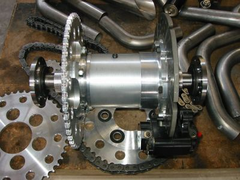

Rescued attachment Torsen_02_sml.jpg
chrisf - 12/4/05 at 12:07 AM
Thanks for the pic. How do you keep the oil from leaking out where the driveshaft 'ears' are inserting into the diff?
--Chris
Rorty - 12/4/05 at 12:27 AM
quote:
Originally posted by chrisf
Thanks for the pic. How do you keep the oil from leaking out where the driveshaft 'ears' are inserting into the diff?
--Chris
There's no direct route from the output shafts to the oil inside. Some output flanges require an O-ring, but some are actually stub shafts which
are sealed.
It depends from one application to another.
On BMWs (and some others), the only thing sealing the drive flange and holding the complete CV and axle to the diff is an O-ring!
chrisf - 12/4/05 at 12:51 AM
I think I'm missing something then because I'm not following. In the picture, the fancy bit is the casing that encloses the diff/LSD. The
output shafts (thanks for the correct term) are splined sections that slide into the differential. Do they not have to pass through the custom casing
that is filled with oil?
Perhaps I need to buy an LSD and have a look at how these things work. Do you reckon a BMW is a good candidate for the application?
--Thanks for the help, Chris
Rorty - 12/4/05 at 01:40 AM
quote:
Originally posted by chrisf
I think I'm missing something then because I'm not following. In the picture, the fancy bit is the casing that encloses the diff/LSD. The
output shafts (thanks for the correct term) are splined sections that slide into the differential. Do they not have to pass through the custom casing
that is filled with oil?
Perhaps I need to buy an LSD and have a look at how these things work. Do you reckon a BMW is a good candidate for the application?
--Thanks for the help, Chris
The Torsen unit, in the post above, has male drive flanges which are about 160mm long and have splines on their inner ends. These do run into the
centre of the diff amongst the other components and the oil and they either require O-ring grooves machined into the shoulders to seal properly, or
sealed outer bearings.
As I said though, some male flanges are inserted into sockets and are isolated from the oil.
Some drive flanges are female and are circlipped onto the male splines of the stub shafts.
I only mentioned the BMW diffs as I'm quite familliar with them too; I've used them and their CVs and axles on many occasions. The larger
cars (7 series?...can't quite remember) use the same infamous "930" CVs as the Porsche 911 Turbo. They'll cope with big amounts of
horsepower and torque.
Sven - 12/4/05 at 02:52 AM
FWIW, chrisf is the other party in the aforementioned private discussion. He and I have been discussing BEC engined middies for some time and
we've been researching converting a car diff to chain driven.
Looks reasonably straightforward now we've talked to just about everyone that knows and read everything we can find ... 
I'm intrigued about how to convert a FWD transaxle because my impression is that they are usually lighter weight than a typical RWD differential
and, probably, easier to source. I'll just have to obtain one and stare at it while holding a beer, that usually works for everything else.
-S
Rorty - 12/4/05 at 03:08 AM
quote:
Originally posted by Sven
I'm intrigued about how to convert a FWD transaxle because my impression is that they are usually lighter weight than a typical RWD differential
and, probably, easier to source. I'll just have to obtain one and stare at it while holding a beer, that usually works for everything else.
-S
I can highly recommend the Golf diff in that case. Once you have it fitted, you can swap it over to a Quaiffe, or even better, a Peloquin diff.
There are dozens of suitable axle lengths available too (different lengths on each side of a Golf plus various different models). You can also buy
racing CVs off the shelf for the Golf CV PCD. 
sgraber - 12/4/05 at 04:02 AM
Steve, Sven, whatever your name is... LOL
Since you are in Phoenix, we need to get together soon to discuss this chain diff issue.
My neighbor just gave me a Honda differential from a mid 90's Acura LS 5 speed and it's a small, lightweight unit. I can easily see that
it's only 6.5" from bearing to bearing. Once I remove the main gear I'd bet it's only a few pounds.
Graber
kb58 - 12/4/05 at 04:19 AM
quote:
Originally posted by sgraber
Steve, Sven, whatever your name is... LOL
Since you are in Phoenix, we need to get together soon to discuss this chain diff issue.
My neighbor just gave me a Honda differential from a mid 90's Acura LS 5 speed and it's a small, lightweight unit. I can easily see that
it's only 6.5" from bearing to bearing. Once I remove the main gear I'd bet it's only a few pounds.
Graber
Alright Steve/Sven/Graber, are you writing this to yourself? I think it's time to give your other selves a rest...
Rorty - 12/4/05 at 04:24 AM
quote:
Originally posted by sgraber
Steve, Sven, whatever your name is... LOL
Since you are in Phoenix, we need to get together soon to discuss this chain diff issue.
Graber
I expect a full dissertation from Phoenix by next Monday! 
sgraber - 12/4/05 at 01:32 PM
damn ! You're onto us... Brothers from different mothers... 
j/k
Sven - 12/4/05 at 03:24 PM
quote:
Originally posted by sgraber
damn ! You're onto us... Brothers from different mothers... 
j/k
Steve got the brains and I got the stunning good looks.
Hey Steve, doesn't the Honda motor/diff rotate in the opposite/unconventional direction, meaning it would be perfect for your new aquisition?
I'm excited about this whole thing and seeing your car ... let's make a date.
Rorty, sounds like the VW diff is perfect for me, as I'm planning to use a R1 motor.
-S
Rorty - 12/4/05 at 10:11 PM
quote:
Originally posted by Sven
... let's make a date.
-S
OK guys, don't forget the diff the the primary concern here. 
Spyderman - 12/4/05 at 10:33 PM
quote:
Originally posted by Sven
He says in his diary he has a welded up spider gear that he plans to use, which is, essentially, a locked diff/spool.
AFAIK, all the lakes racers use frames made from scraps of wood and fibre board ...  ...
...
-S
Must admit I never read all the text, just skimmed over it!
Still seems like a lot of unnecessary work using a diff at all.
Can't understand why they would want to add weight when using such a small capacity engine. Seems counter-productive to me!
Why use the wood if it is not to keep weight down? 
Not argueing, just don't understand the logic! 

Terry


ERP - 13/4/05 at 12:27 AM
They don't care about the weight because getting to 200+mph is all about aerodynamics. The weight in this application is for the most part
meaningless, it might cut down your 0-100 time by a fraction of a second, but it won't affext your top speed significantly.
When you worried about power to the ground vs a force which is proportional to velocity^3. It's all about the last 50 mph not the first..
Although I happen to agree with you the diff seems unnecessary in this application.
Spyderman - 13/4/05 at 11:57 AM
Not wishing to be arguementative, but would disagree quite strongly about the weight issue.
Whether acceleration rate is high or low the mass still has to be accelerated upto the intended speed. Forgetting aerodynamics for the moment, the
greater the mass of an object, the greater the power needed to achieve the same results, especially in terms of frictional losses. Simple physics!
In order to achieve new records you need to alter the balance in your favour. Here he is trying to beat the speed record for a certain engine class.
The only way to do that is to either have more power available or to have less weight (frictional losses being considered a constant to simplify)!
Both would be preferable! 
Still, the fact that it has encouraged debate is significant in itself! 

Terry


andkilde - 13/4/05 at 01:03 PM
quote:
Why use the wood if it is not to keep weight down? 
I'm pretty sure the wood is just a mockup Spyderman -- to be re-created in steel once he's got his design fully sorted.
Cheers, Ted
chrisf - 13/4/05 at 01:11 PM
Just to throw out another idea...Have you looked at ATV differentials from IRS ATVs? Knowing absoluetly nothing about them, perhaps they too are shaft
driven and spin in the oposite direction. They are certainly small. To the best of my knowledge, the only RWD Honda that I know id the S2k, and that
spins in the proper direction.
Maybe the CRV diff would work. I have a friend that had one and wrecked it. The insurance adjuster told hime that the CRV was very crumble prone, and
thus most frontal collisions netted in a total write-off. If you look, the CV joints and halfshafts may be ideal. Perhaps you can check with your
honda friends and see what they think.
I still think the chain drive is a better idea, but the ATV diff could be another possibility.
--Chris
ERP - 13/4/05 at 05:28 PM
quote:
Originally posted by Spyderman
Not wishing to be arguementative, but would disagree quite strongly about the weight issue.
Whether acceleration rate is high or low the mass still has to be accelerated upto the intended speed. Forgetting aerodynamics for the moment, the
greater the mass of an object, the greater the power needed to achieve the same results, especially in terms of frictional losses. Simple physics!
In order to achieve new records you need to alter the balance in your favour. Here he is trying to beat the speed record for a certain engine class.
The only way to do that is to either have more power available or to have less weight (frictional losses being considered a constant to simplify)!
Both would be preferable! 
Still, the fact that it has encouraged debate is significant in itself! 

Terry


OK assuming that the car is entirely aerodynamics limited i.e not limited by it's gearing, then we have
Fnet = Fdrive - K*velocity^3
ma = Fdrive - k*velocity^3
it's maximum speed is derived by solving
0 = Fdrive - k*velocity^3
Note, no mass in the equation. Now this is a gross simplification and does assume that you have an infinite amout of time and space to reach the
limit, in the real world it's more like
0 = (Fdrive - k*velocity^3)-(m*amin)
where amin is some small number where we aren't getting useful accelleration.
mass is a factor, but the Velocity^3 term is dominant, and the closer we get to our theoretical maximum the less important Mass is.
So yes mass matters, it dictates how quickly tou get to the point of diminishing returns, but it's not as important as say on a dragstrip car
where you are still accellerating at a significant rate at the end of the run.
[Edited on 13/4/05 by ERP]
tigris - 15/4/05 at 10:44 AM
how do you mount this type of diff? Is it just floating and supported by the axles? am I missing something?
Rorty - 15/4/05 at 12:56 PM
quote:
Originally posted by tigris
how do you mount this type of diff? Is it just floating and supported by the axles? am I missing something?
The diff is supported by bearings (in their original positions) which are clamped to the chassis or bulkhead.

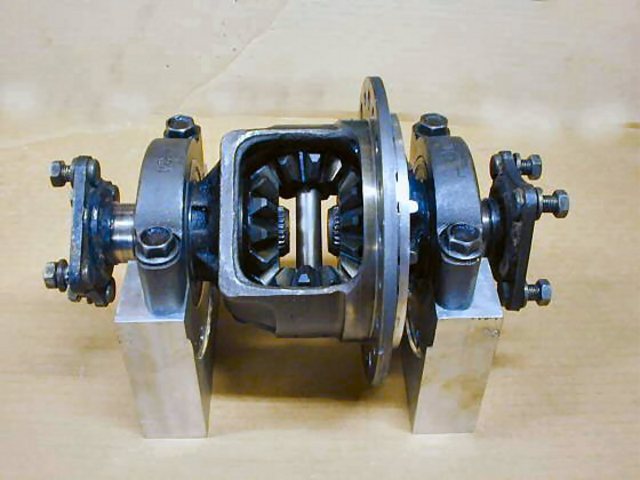
Rescued attachment diff-machining_24.jpg
Rorty - 15/4/05 at 12:59 PM
Here's another:

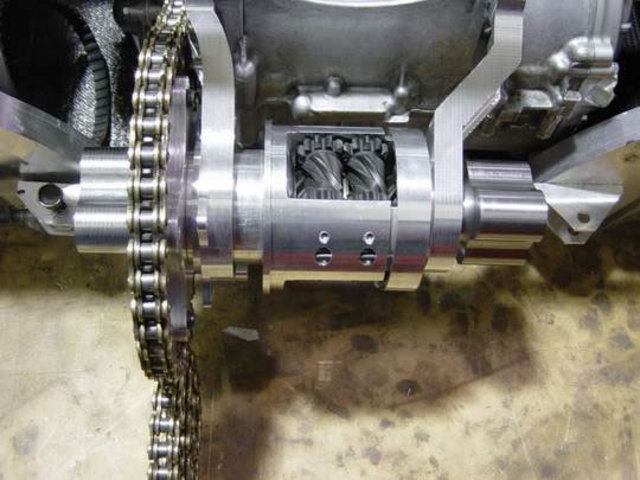
Rescued attachment diff_housing03.jpg
Rorty - 15/4/05 at 01:02 PM
...and another:

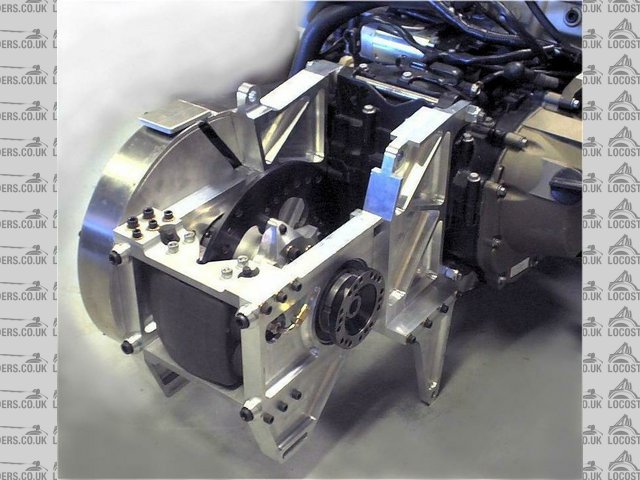
Rescued attachment ZX12_trans.jpg
Rorty - 15/4/05 at 01:07 PM
....wait....there's more:
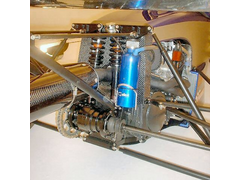

Rescued attachment Saxon_rear_bulkhead.jpg
The Shootist - 15/4/05 at 02:57 PM
The CRV uses on-demend awd. The rearend is a spool with the axles coupled via electric clutches. everything is disengaged under normal conditions but
when the ECU senses splippage in the front wheels the rear clutches engage and pushes the car untill slippage stops.
I've jumped on the wifes CRV pulling out of a side street only to have the rearend kick in and jerk the front of the car back over in a straight
line.
This is the same tried and true system that Honda has used since the Civic Wagon 4X4 in the 80's.
Now it may be possible to spring load the cluthes and turn the honda diff into an LSD, but that would be highly experimental.
It is a pretty tiny rearend though.
kb58 - 15/4/05 at 03:29 PM
Rorty, that center diff assembly is really sweet... someone needs to sell them!
Rorty - 15/4/05 at 10:21 PM
quote:
Originally posted by kb58
Rorty, that center diff assembly is really sweet... someone needs to sell them!
Funny you should say that. I've had machinists and fellow competitors standing around such completed assemblies, all oooh-ing and ahhhh-ing
stating it would be a crime against humanity not to put the units into production. But try and secure an order for one from anyone and all you'll
here is "I'll have one if the price's right, how much are they?"
"To you sir, they're $x,xxx, but if I can get some indication of commitment and numbers, then the price will be $x,xxx less $xxx"
In other words, it's the usual scenario where everyone wants one and nobody will buy one.
Perhaps if I had a degree in marketing I could sell them, but I don't. If I was brave enough, I'd just produce a run of, say, fifty of them
and then mark them up appropriately. 
Rorty - 16/4/05 at 01:11 AM
quote:
Originally posted by The Shootist
The CRV uses on-demend awd. The rearend is a spool with the axles coupled via electric clutches. everything is disengaged under normal conditions but
when the ECU senses splippage in the front wheels the rear clutches engage and pushes the car untill slippage stops.
This is the same tried and true system that Honda has used since the Civic Wagon 4X4 in the 80's.
Does anyone have a workshop manual or any other material showing this diff in detail?
I've driven behind CRVs in the past, and always thought the diffs and axles looked very neat and tidy.
CD-5 - 20/4/05 at 01:14 PM
Listing diffs possibility anyone?
Anyone tought about making a list of the potential donnor diffs, type and the car it is from? Ratio for non chain drive use...
Maybe some civic one for non lsd, subaru,etc...
Keping in mind the availability and cost.
I'm willing to put it in writing. Ithing it would be verry helpful for every one preparinfg a MID-BEC....
 fancy driving inside a wooden body at anything above 100mph.
fancy driving inside a wooden body at anything above 100mph. 


 ...
... 











